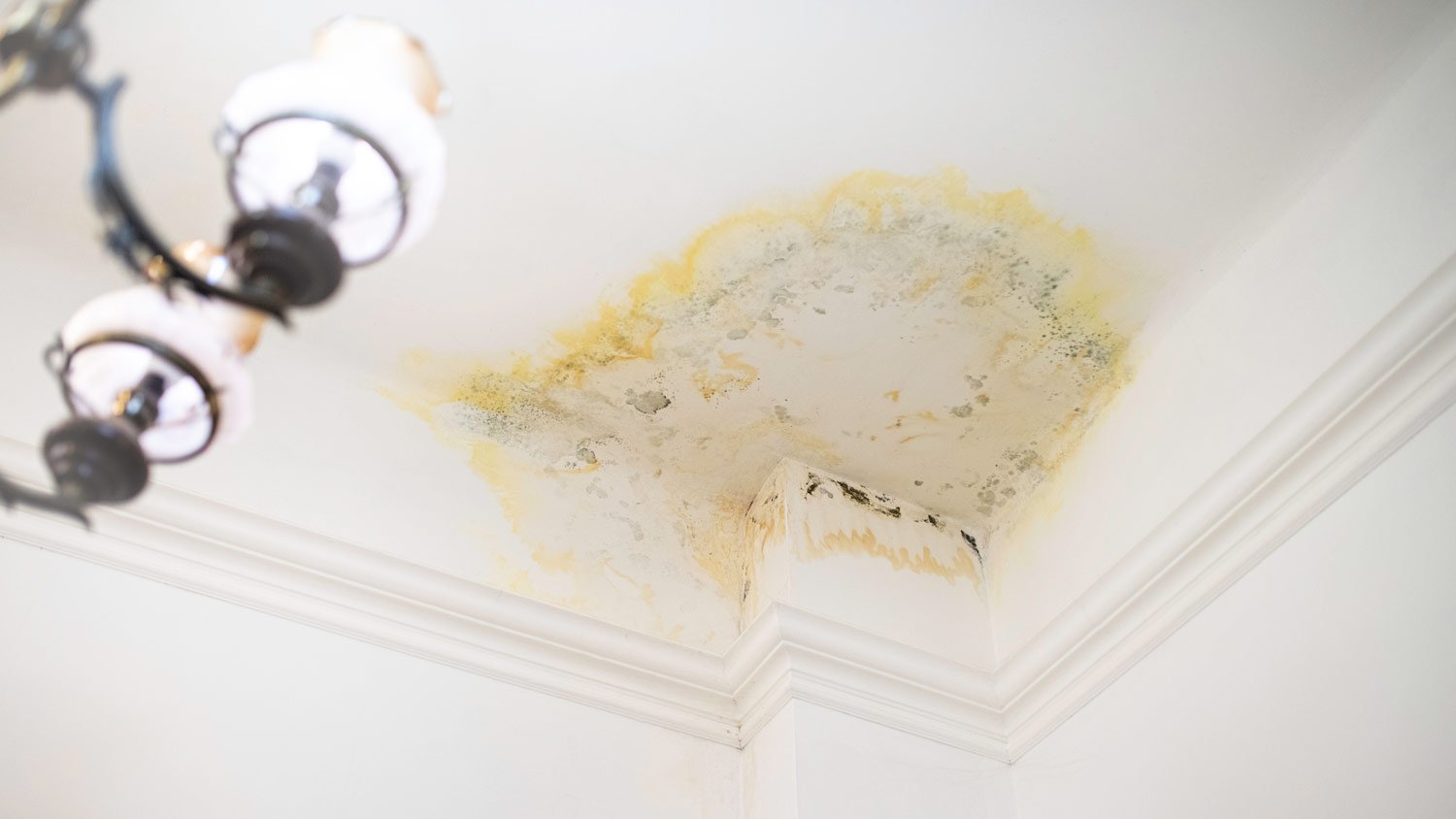Why Water Is Dripping From Your AC Vent
If a sneaky AC leak creeps out every time it rains, here's what to do about it


There's nothing quite like a summer rainstorm to break the humidity and cool things down. But a rainy afternoon can quickly lose its charm when the water makes its way into your AC vent. There are a few reasons why water drips from an AC vent, including a leak in your home’s exterior and an HVAC malfunction. Here are some things to check for when investigating a leaky AC vent, and steps you can take to fix it, so that you can enjoy the pitter-patter of the rain from the dry comfort of your couch.
1. There's a Leak in Your Attic
By the time a leak becomes obvious, there's a strong possibility the water's been hanging out in your home for longer than you realized. For example, water dripping from your AC vent may have gotten there from another entry point.
In many cases, most of your AC vent investigation happens in your attic or close to your roof. When a roof leaks, the water can land on the ducts and make its way into any cracks or open seams. Eventually, it travels down your ducts and out of the vent in your home.
What to Do About It
Head up into the attic and look for evidence of troublesome water damage. Telltale signs may include a musty smell, a damp area of wood or plaster, or patches of brown or black mold. If possible, head up during or just after rainfall to try to catch the source of the drip.
Remember, the leak itself may not come from a crack in the shingles, but rather from broken or missing areas around an attic vent. So, take extra care to inspect below any exhaust pipes or roof vent work. Water likes to travel—so it could be coming from further away than you'd expect.
2. Damaged Shingles on Your Roof
Driving rains—which are gusty rains during an intense storm—can test even the strongest roofs, shingles, and ventilation systems.
If you notice that the rain only appears in your AC vent during a particularly drenching or windy storm, extreme weather could be the culprit. Inspect your shingles for water damage or deterioration, as well as the protective flap in your attic vents.
What to Do About It
Take note if you detect water the next time you have a small-to-mid-sized storm. While you should always address any level of water damage, especially since the cost to repair water damage can reach upwards of $6,000, it could have been a one-time occurrence. It's also important to note if the water is coming through your bathroom fan. Your bathroom vent sends moisture to the outside of your home. Driving rains, poor flashing, or a broken vent could make it more susceptible to strong rainwater entering the wrong direction.
3. Vent Pipe Leaks
A bit of condensation is nothing to worry about, but if you spot water dripping from your AC vents, you need to take a closer look. Dirty air filters can clog the vent and force water to go where it shouldn’t. If your AC is in the attic, you could have a clog in your condensation drain line and a decaying drain pan.
What to Do About It
First, try changing out your air filter to see if that gets the water flowing properly again. If your vent leak persists, you might need to call in a pro to flush your drain line and replace the drain pan. This is especially true if you live in a humid climate.
4. Skylight Leaks
Like an attic or roof leak, water dripping from your skylight is usually a byproduct of another issue. Most commonly, damaged roof flashing can cause water damage, but so can indoor condensation. When humid air meets cooler surfaces—like in your bathroom—moisture can build up and drip from your AC vent. This is actually not an AC problem, it’s an air quality problem.
What to Do About It
To avoid dampness in your home, turn on a fan or crack a window while showering. For a longer-term solution, consider using a dehumidifier to regulate moisture. That way, you keep your skylight intact and avoid excessive condensation that can rust and break down your systems faster.
5. Your HVAC Is on the Fritz
There are a handful of reasons why your AC vents could leak without an outside water source like rain. Common issues include:
Clogged Condensate Drain Line: The condensate drain line for your AC runs from the system to the outside of the home. The condensation on the evaporator coils exits via this drain. Clogs in the condensate drain line aren’t unusual (thanks to dust and mildew), but you’ll need a pro to do some maintenance and flush it out.
Low Refrigerant Due to a Leak: If your AC refrigerant is leaking, you might notice higher energy bills, your unit taking longer to cool your house down, or a hissing sound.
Frozen Evaporator Coils in the Winter: Dirty evaporator coils might freeze over during chilly months, especially if you also have low coolant levels. The restricted airflow can damage your unit.
Dirty Air Filters: Change your AC’s air filters every one to three months. Otherwise, leaving dirty air filters is one AC mistake that can cost you and block airflow (which can lead to frozen evaporator coils).
Poorly Installed Drain Pan: The condensation carried away via the condensate drain line drips into the drain pan. You may have a leak due to a faulty install, rust, clogs, and cracks in the pan.
So if your AC is experiencing the issues above or another problem, the moisture from the air it’s cooling could move in the wrong direction and show up as a leak in a vent or around the unit.
What to Do About It
Begin by ruling out the direct connection to the rain. When you're several days past the last rainfall, look for signs of new water spots in and around your vents. If the water appears outside a storm, call your HVAC team ASAP for a look.
Who to Call When Rain Leaks From Your AC Vent

Figuring out the source of a leak is doable, and focusing your attention on your AC unit is a great way to narrow down the problem. The faster you find the leak, the better—no one wants to deal with the extensive cost of water damage.
The best way to start is to call a local HVAC specialist, as leaks can impact more than just your AC—they can affect your vent work, too. Additionally, you'll want to address the crack that allowed the water inside in the first place.
If you or your HVAC team spot a leak in the roof, get a roofing team in for a thorough inspection. It's never worth climbing up on the roof yourself and risking a fall. If the pros locate a leak, your next step is to call a water damage restoration company to double-check for mold, wet drywall, or damaged insulation.
AC vent leaks can be concerning, especially if there's a wet and wild storm outside. Even the smallest leaks in our roof, eaves, or vents can cause problems over time, so don't be afraid to call in an expert for an extra look.
Questions to Ask the Pro
Your home’s HVAC network extends throughout your entire house, covering areas like your kitchen, bedrooms, bathrooms, and all connecting walls. If you’re experiencing a leak, you need to get a professional HVAC specialist out to your house to resolve the problem. Don’t pick the first one you find. Instead, contact several specialists until you find one that works for you.
An initial phone call can help you narrow down your options based on their experience, knowledge, and project cost estimates. Before you hire them, schedule an on-site meeting where they can properly assess your issue. This will help you get a more accurate estimate and hash out any other questions or concerns.
To find a skilled and affordable HVAC specialist, use this list of questions to help you narrow down your options:
Are you licensed?
How many years of experience do you have?
Can you provide customer testimonials on your recent work?
Do you have insurance coverage, and does it cover accident damages?
Do you offer warranties or guarantees?
Will you inspect the entire HVAC system, including its electrical components and ductwork?
How long will the repair take?
How much will the job cost?
Frequently Asked Questions
If you notice water accumulating in your vent due to a roof or plumbing leak above your ductwork, it's essential to promptly identify the source of the leak and undertake any required repairs without delay. Such leaks have the potential to swiftly result in water damage within your home, ultimately leading to mold and mildew concerns.
Water accumulation can occur due to either leaks or condensation on or near cooling coils. It's crucial to inspect for leaks, perform necessary repairs, and ensure regular maintenance checks for your coils and drain pans. Be sure to empty the drain pans completely, as any standing water in the pan indicates that it is not functioning as intended.





- How to Fix an AC Leak: A Step-by-Step Guide
- How to Stop Condensation on AC Unit: 6 Tips to Try
- 8 Signs of a Roof Leak and What to Do About It
- 11 Reasons Your AC Is Blowing Hot Air
- What to Do If Your New Roof Is Leaking
- Why Does My AC Smell? 7 Possible Problems and How to Sniff Them Out
- How to Troubleshoot Your Air Conditioner: 12 Common Problems and Tips to Fix Them
- 6 Signs You May Have an AC Coolant Leak and Tips to Prevent It
- How to Clean and Unclog a Plumbing Vent Without Getting On the Roof
- Why Is My AC Leaking Water? 5 Common Causes and How to Fix It










